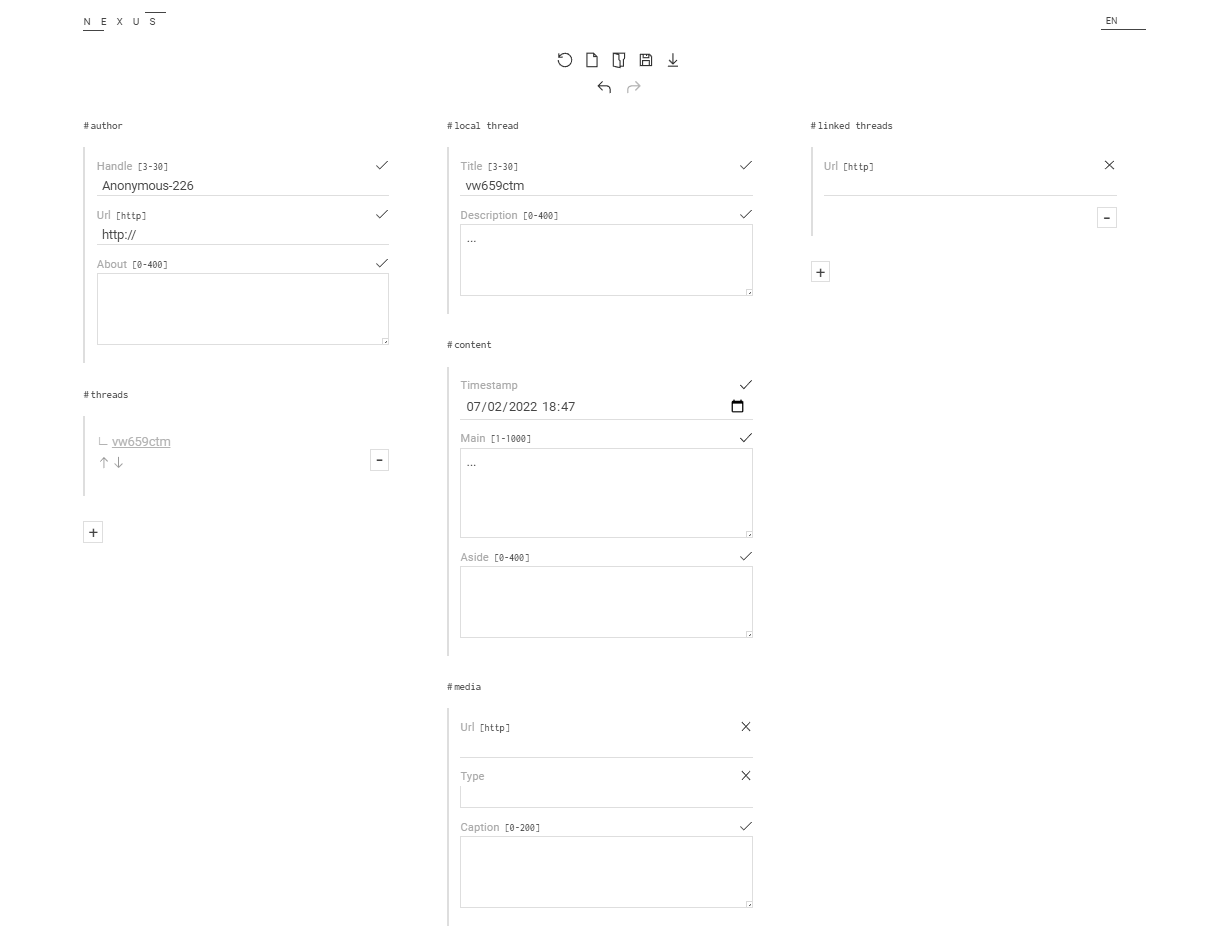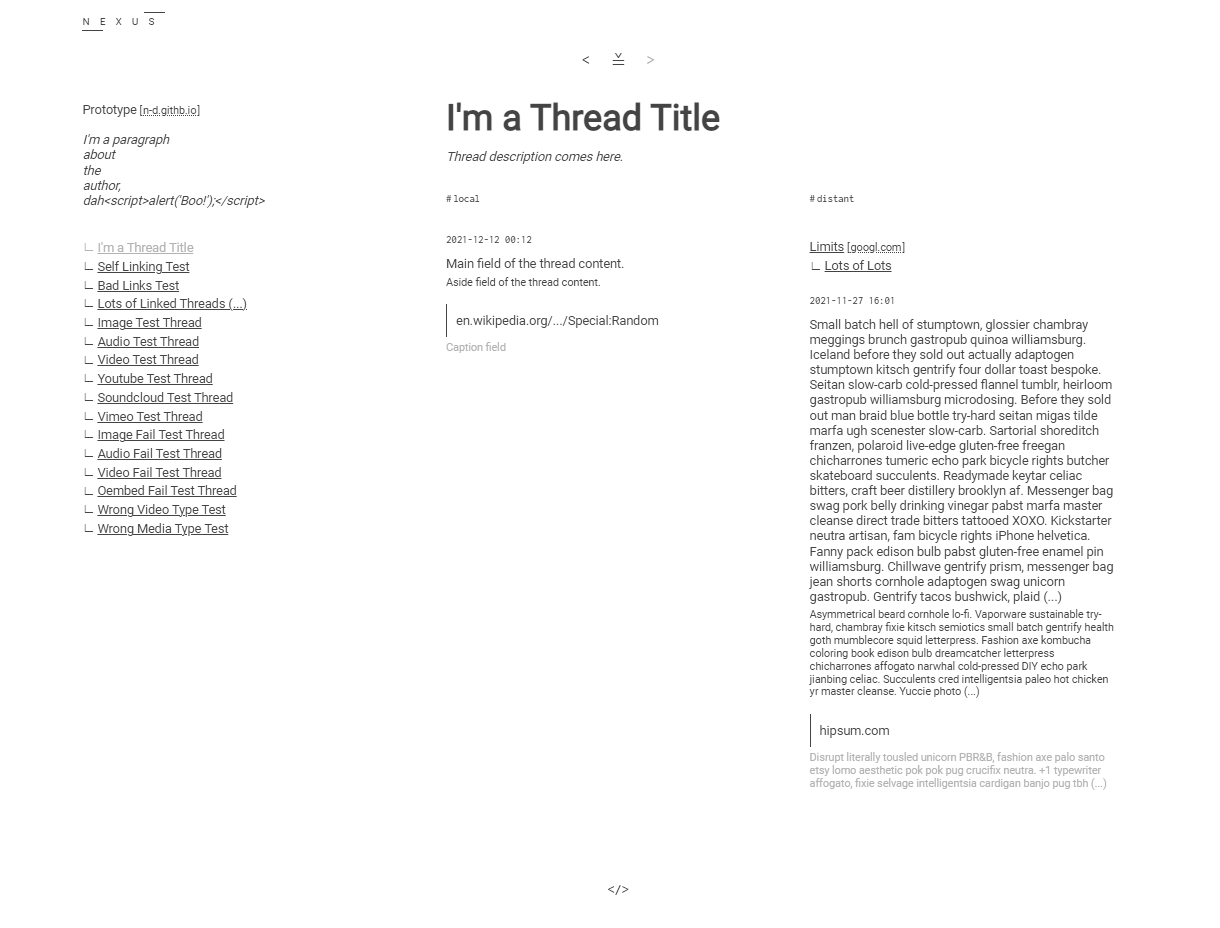Nexus is a Peer-to-Peer Micro Social Network.
Nexus IO is a Nexus reader and editor app in vanilla JS.
Demo available on the project website: nexus-dock.github.io
Copy the snippet, change the data-src, and paste it in an html page.
<div id="Nexus" data-src="http://website.com/path/to/your/nexus/file.json#optional-thread-id"></div>
<script src="https://cdn.jsdelivr.net/gh/I-is-as-I-does/Nexus@latest/dist/js/NxIO.js"></script>data-src
Required.
Specify here the url of the Nexus json file you wish to display.
Add #some-thread-id to target a specific thread.
If the page containing the snippet is on the same server as the Nexus file, it can be a relative path;
for example:source/nexus.json#first-thread.
Otherwise, it must be an absolute path starting withhttp://(orhttps://).
data-style
Optional.
Specify here the url of the theme you wish to use.
If you’re fine with the default theme, you can omit this parameter.
If the page containing the snippet is on the same server as the theme file, it can be a relative path;
for example:assets/theme.css.
Otherwise, it must be an absolute path starting withhttp://(orhttps://).
data-lang
Optional.
Specify here the default language the app should use.
If omitted, the app will look for the language specified in the html tag, or fallback to English.
Note that if another language is picked through the interface, this choice will be cached and preferred over the default setting.
Currently supported languages: en, fr.
Additional translations are much welcomed!
In your browser address bar, add ?new or ?edit to the current url.
If a query string is already present, use &new or &edit instead.
Add ?log (or &log) to the current url.
Among other things, this can be useful to understand why a distant Nexus is not loading.
< ≚ >
History module.
</>
Snippets module.
First Column
Current Nexus author and threads list.
#local
Current thread description and its content.
#distant
Other threads and instances linked to the current local thread.
If there is more than one distant content, you can navigate them using ⊻ and ⊼.
Clicking on an author handle will load its Nexus.
To display a thread, pick one in the index list.
Thread links in the distant module will both load the distant Nexus and related thread.
If a thread has not yet been visited, or if its content has been updated since your last visit, its link will be followed by an asterisk: *.
To reset hints, clear the app cache.
In your browser address bar, add ?clear to the current url.
If a query string is already present, use &clear instead.
This will not erase the editor local saves.
Indications between brackets are hints at the field requirement.
[3-30] for example indicates min. and max. characters.
[http] states that the field must be a valid http url.
A valid field is marked with a ✓, an invalid one with a ✗.
Make sure all your fields are valid, or your Nexus might not load at all.
When you enter a Nexus url in a linked threads field, the app will check if it loads correctly.
If the field gets marked as invalid, there’s probably something wrong: either the link is broken, the distant Nexus data is invalid, or the request was refused.
The form will try to guess which type of media url you’re sharing and automatically set the media Type field.
Just make sure it got it right!
Switch to Preview Mode by clicking on the eye icon.
Revert to the editor with the pen icon.
Back and forward arrows lets you undo / redo your last action.
Circling arrow will revert data to its original state.
File icon create a new Nexus.
Folder icon allows you to load a Nexus .json file from your device.
Save icon temporarily store the current state in your browser cache.
new and edit keywords have independent save slots.
To erase editor saves: in your browser address bar, add &erase to the current url.
If you configured your browser to prevent the use of local storage, there is no backup.
If you clear up your browser cache, the data will be gone.
The cache is also domain dependent. If you edit your data from another website, the saved data will not be available.
Downward arrow will generate a .json file and download it on your device. This is the safe and sure way to save your Nexus data.
This app uses Nexus Core for a good part of its logic; you might want to take a look at this repository too.
It will be installed as a dependency.
git clone https://github.com/I-is-as-I-does/Nexus-IOnpm installTarget directory: public/
npm run build:devTarget directory: dist/
npm run build:prodProject website: nexus-dock.github.io Project hub repository: github.com/I-is-as-I-does/Nexus
This project is under the GNU AGPLv3 License.

